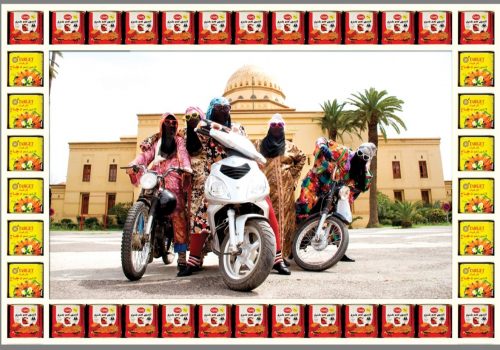At the historic Somerset House in London, Hassan Hajjaj presents Kesh Angels alongside his recent project My Rock Stars. The British-Moroccan photographer, known for his famous pop portraits combining documentary practice and fashion photography, offers a unique, upbeat interpretation of a blend of Anglo-Saxon and North-African cultures.
The female bikers in the series Kesh Angels are provocative and intriguing. Clearly meant as a counterpoint to the male group Hells Angels with their emblematic testosterone-charged Harley Davidsons, this series creates a new alliance around cultural hybridity and womanhood. Wrapped in ornate fabrics and wearing multiple accessories, the young women sit astride their motorcycles or mopeds, cutting a proud figure. Printed on large sheets of metal, these imposing riders shimmer, taking on colors that evoke the chrome of their bikes.
Nike socks and Moroccan babouches, fez hats and floral dresses, shutter shades and niqabs:the numerous assemblages featured in these photographs have been meticulously researched and are used to glorify intransigent heterogeneity. Posing in Marrakesh in various settings, from closed doorways to official buildings, Kesh Angels are iconoclastic urban figures. Leaning forward on their bikes, the young models seem to be revving their engines, ready to hit the road and cross borders. The series Kesh Angels subverts the usual association of “veiled” with “submissive.”
Sounds and vibrations come from the second room, contrasting with the austere calm of the neoclassical Somerset House. My Rock Stars includes a video installation and a series of photographic portraits that explore visual and sound cross-fertilization between Morocco and England. Installed side by side, the videos show nine musicians whose costumes and music transcend geographical boundaries. A female rapper comes after a belly dancer, a folk guitarist gives way to a blues piano player: styles of music and bodies follow one another and communicate.
In the middle of the room a couch made of plastic crates, with sixties-style cushions and Louis Vuitton-patterned throws, awaits visitors. The eclectic music and décor echo the exhibited photographs. Wearing outfits with chuckle-provoking references to “hipster chic” or “rude boy,” the musicians present a visual palette of their influences. Posing with their instruments against motley backgrounds whose grainy texture is reminiscent of those ubiquitous plaid storage bags brought to Africa from China, the models play with and appropriate the codes of globalization.
Soda cans, boxes, and other packaging, line the frames of the photographs in Kesh Angels and My Rock Star, transforming “disposable” objects that are part of the cycle of production, consumption, and recycling. Labeled in Arabic and exhibited in a London institution, these commercial products paint a portrait of a globalized marketplace. Evoking the photographer’s intercontinental journey and his identity markers, the exhibition La Caravane will transport you from one place to another, all the while showing you the creative potential of an encounter.
Julie Bonzon
Julie Bonzon is a PhD candidate in art history at University College London (UCL), UK.
Hassan Hajjaj, La Caravane
October 5, 2017 to January 7, 2018
Somerset House
South Wing Strand
WC2R 1LA London
United Kingdom
















